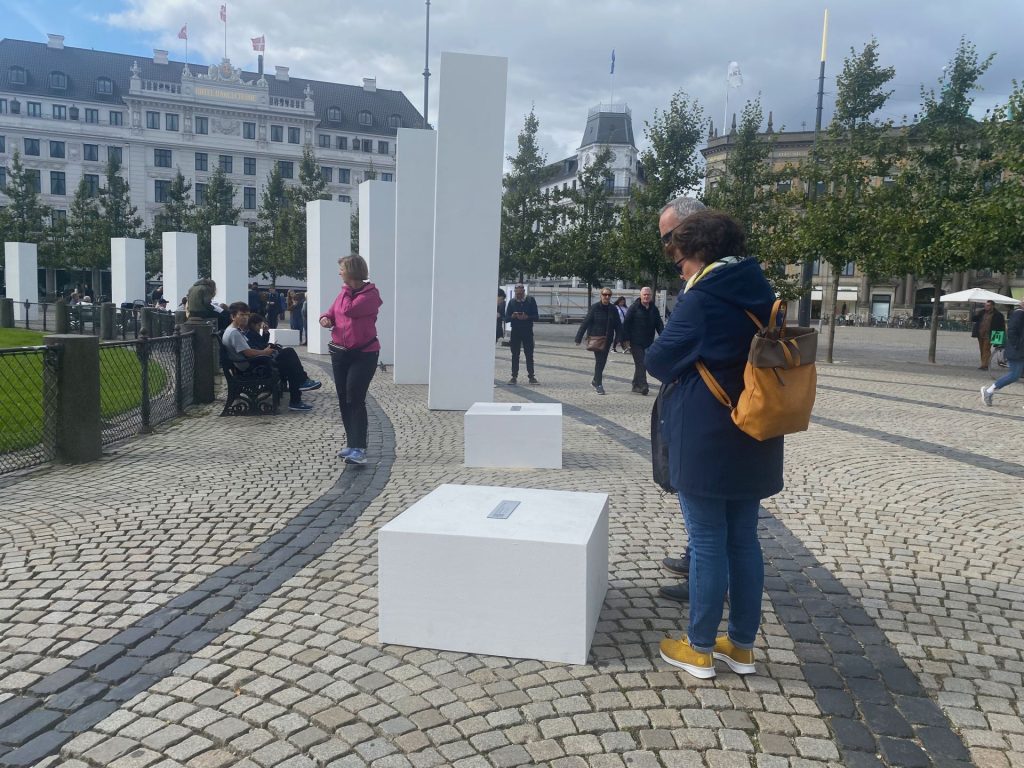By Chelsea Al Arif on Friday, September 16, 2022

The statue of 17th-century King Christian V in the heart of Copenhagen’s old town was ringed with 50 empty white pedestals to symbolise: more women! This exhibition was an attraction to a great number of internationals.
Each pedestal contains the name of a significant woman in Danish history and more details on their accomplishments. The artwork is a momentary exhibition and was developed by Bjarke Ingels Group, or BIG’s youngest female partner, Giulia Frittoli.
Tourists, locals, and residents gathered around to admire the silent cry for equality as the thought that unified them was holding on to the fact that the underrepresentation of women is underrated and more initiatives must be taken.
The exhibition started off as an installation during the festival celebrating the 50 years anniversary of The Queen of Denmark’s accession to the throne until it developed to become an attraction to hundreds of spectators feeding on knowledge about influential Danish women that are never recognized.

Fritolli told ‘dezeen’: “As more focus is brought to issues of social justice and equality, we are so proud and honored to contribute to the conversation and give a voice to those who haven’t been heard.”
The team comprised a female-dominated jury of a former politician, a visual artist, numerous history professors and researchers, and the director of the National Gallery of Denmark to pick the final 50 women. The judges chose a diverse group of women, including scientists, two designers: Lise Le Charlotte Klintand, a lighting designer, a furniture designer, musicians, politicians, and authors.
It comprises 49 white pedestals of varying heights, each representing a historical woman, as well as a single unidentified pillar where people can recommend further women to include by scanning a QR code that allows them to voice out who was missed. Unlike the other wooden plinths, this pedestal is covered in mirrors.
Rose Chang, a British tourist in Copenhagen, looked at the pedestals and said: “It is beautiful that people are doing such initiative, I think it is only equal and fair to have the same representation for men and women in this modern day.”
On the installation site, it was impressive to observe international students reading off of the pedestals with their classmates while they were on a school trip to the exhibition. The exhibition caught the eye of international feminists and women’s rights activists who tweeted about it and reposted the news.

Rym Badran, founder of Girl Up Arab World, heard about the exhibition all the way from Lebanon and said: “Those white blocs are a source of a loud message because they represent today’s reality without trying to sugarcoat it. It is simple yet brutal. These blocs represent the fact that women achievements are overlooked, our history books and collective memory don’t acknowledge and celebrate women.”
In an article published by Megan Gospe in the University of Idaho’s Women’s centre, a review of history textbooks revealed that the text allotted to references to women amounted to less than one page in one with 819 pages. A closer look at some other publication’s offerings revealed that there were four illustrations of men for every one of women, and that less than 3% of the text has been about women.
To many, 50 queens were not enough and more names should have been added. In an attempt to delve deeper into the other nominees for this exhibition, an interview with KULU’S Chair, Janice Førd revealed: “We agree that the field of women’s rights, gender equality and development is not represented and have a couple suggestions for missing outstanding women in this field.”
Førd nominated the Danish economist Ester Boserup for “Her important study, Woman’s Role in Economic Development, investigated the distribution of responsibilities between men and women, launching decades of later work that linked gender issues to economic development difficulties, finding out that many economic burdens landed disproportionately on women.”
These initiatives must not restrict themselves to certain countries, Badran says: “I would love to see this exhibition in all countries of the world. Although, the situation with regards to women’s emancipation and rights is different from one country to another, no country in the world could claim that it has reached gender equality. Thus, in all countries women stories are untold and women’s voices tend to be underrepresented.”
This story is written for an audience interested in women empowerment and the international gender equality community and could be published on unwomen.org and Forbes.
References:
Gospe, M. (2015, November 5). Women Underrepresented in History Textbooks. WordPress.com. from https://uiwomenscenter.wordpress.com/2015/10/30/women-misrepresented-in-history-textbooks/
Ravenscroft, T. (2022, September 5). BIG designs 50 Queens installation to highlight “importance of gender equality.” Dezeen. from https://www.dezeen.com/2022/09/05/big-50-queens-installation-copenhagen-queen-margrethe-ii-jubilee/
Source list:
-Rym Badran
Founder of Girl Up Arab World
+961 81 693 793
-Janice Goodson FØRDE
Chair of KULU
DK – 2400 Copenhagen NV, Denmark
Tel. +45 – 3315 7870, Direct eml. janice@kulu.dk, General email. kulu@kulu.dk
-Rose Chang
Retired Housewife
England
+44 07825910866